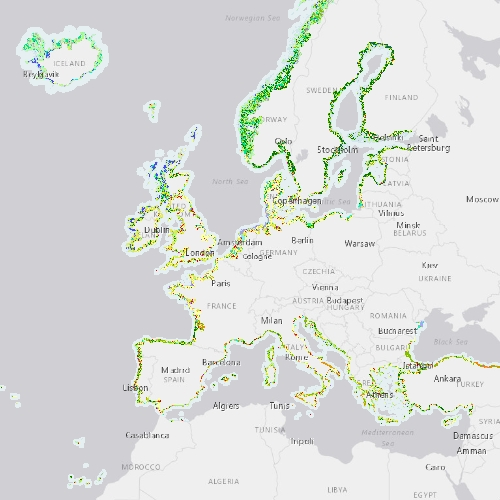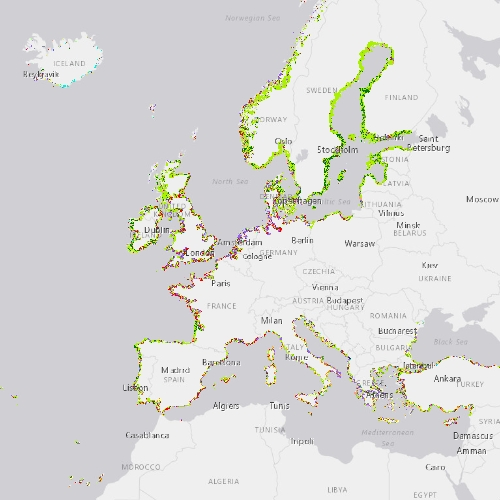10 m
Type of resources
Available actions
Topics
Keywords
Contact for the resource
Provided by
Years
Formats
Representation types
Update frequencies
status
Scale
Resolution
-

The Coastal Zones (CZ) LC/LU product for 2018 is providing a detailed Land Cover / Land Use (LC/ LU) dataset for areas along the coastline of the EEA38 countries and the United Kingdom, with reference year 2018 for the classification. This product monitors landscape dynamics in European coastal territory to an inland depth of 10 km with a total area of approximately 730,000 km², with all the relevant areas (estuaries, coastal lowlands, nature reserves). The production of the coastal zone layers was coordinated by the European Environment Agency (EEA) in the frame of the EU Copernicus programme, as part of the Copernicus Land Monitoring Service (CLMS) Local Component. The Coastal Zones product covers a buffer zone of coastline derived from EU-Hydro v1.1. Land Cover/Land Use (LC/LU) layer is extracted from Very High Resolution (VHR) satellite data and other available data. The class definitions follow the pre-defined nomenclature on the basis of Mapping and Assessment of Ecosystems and their Services (MAES) typology of ecosystems (Level 1 to Level 4) and CORINE Land Cover adapted to the specific characteristics of coastal zones. The classification provides 71 distinct thematic classes with a Minimum Mapping Unit (MMU) of 0.5 ha and a Minimum Mapping Width (MMW) of 10 m. The product is available for the 2012 and 2018 reference year including change mapping. This CZ dataset is distributed in vector format, in a single OGC GeoPackage SQLite file covering the area of interest. You can read more about the product here: https://land.copernicus.eu/en/products/coastal-zones/coastal-zones-2018.
-

The Coastal Zones LC/LU Change (CZC) 2012-2018 is providing the Land Cover / Land Use (LC/ LU) change for areas along the coastline of the EEA38 countries and the United Kingdom, between the reference years 2012 and 2018. The Coastal Zones product monitors landscape dynamics in European coastal territory to an inland depth of 10 km with a total area of approximately 730,000 km², with all the relevant areas (estuaries, coastal lowlands, nature reserves). The production of the coastal zone layers was coordinated by the European Environment Agency (EEA) in the frame of the EU Copernicus programme, as part of the Copernicus Land Monitoring Service (CLMS) Local Component. The Coastal Zones Change product covers a buffer zone of coastline derived from EU-Hydro v1.1. The Land Cover/Land Use (LC/LU) Change layer is extracted from Very High Resolution (VHR) satellite data and other available data. The reference years for the change are 2012 and 2018. The class definitions follow the pre-defined nomenclature on the basis of Mapping and Assessment of Ecosystems and their Services (MAES) typology of ecosystems (Level 1 to Level 4) and CORINE Land Cover adapted to the specific characteristics of coastal zones. The classification provides 71 distinct thematic classes with a Minimum Mapping Unit (MMU) of 0.5 ha and a Minimum Mapping Width (MMW) of 10 m. The status product is available for the 2012 and 2018 reference years. This CZC dataset is distributed in vector format, in a single OGC GeoPackage file covering the area of interest. You can read more about the product here: https://land.copernicus.eu/en/products/coastal-zones/coastal-zones-change-2012-2018.
-
Représentation des portions de routes départementales concernées par une restriction de circulation relative au tonnage sur le territoire de la Charente (16). Valeur de l'attribut : Définition B8 : Accès interdit aux véhicules affectés au transport de marchandises B8 RSR remorques et semi-remorques B8 SA Sauf autocar B8 SB Sauf bourg B8 UA Sauf usage agricole B8 SR Sauf riverain B8 SDL Sauf desserte locale B10a : Accès interdit aux véhicules, véhicules articulés, trains doubles ou ensemble de véhicules dont la longueur est supérieure au nombre indiqué B13 : Accès interdit aux véhicules, véhicules articulés, trains doubles ou ensemble de véhicules dont le poids total autorisé en charge ou le poids total roulant autorisé excède le nombre indiqué B13 RSR remorques et semi-remorques B13 SA Sauf autocar B13 SB Sauf bourg B13 SA-SB Sauf autocar et sauf bourg B13 SDL Sauf desserte locale B13 SR Sauf riverain
-
Représentation des points de comptage relatif aux trafics routiers sur les routes départementales de la Charente (16).
-

Position géographique des points de mesure du service des réseaux "Pluviaux" de la Communauté d'Agglomération de La Rochelle au débouché en mer des pluviaux primaires et indicateurs de qualité établis à partir des mesures de 2005 à 2008
-
Ce jeu de données est une orthophotographie par satellite Pléiades Neo d'une résolution de 30cm dans les longueurs d'ondes rouge, vert, bleu, infrarouge, red edge et deep blue.
-

La signature isotopique et biochimique des différents producteurs primaires du Bassin d'Arcachon et de son bassin versant est analysée. Les producteurs primaires ont été prélevés sur les 19 stations intertidales considérées dans la fiche de métadonnées:"Cartographie de la matière organique particulaire benthique dans le Bassin d'Arcachon".
-

Contours des réserves biologiques existantes (créées par arrêté ministériel) ou des projets ayant reçu l'avis favorable du CNPN (Conseil national pour la protection de la nature) mais encore en attente de leur arrêté de création. (diffusion publique) Dans les réserves biologiques intégrales (RBI), toute intervention humaine susceptible de modifier le milieu est proscrite : l'objectif de ces réserves est l'étude de l'évolution naturelle de l'écosystème. Dans les réserves biologiques dirigées (RBD), la gestion est orientée vers un objectif de protection d'espèces ou de milieux à haute valeur patrimoniale.
-
Représentation numérique des moyennes journalières concernant les trafics routiers sur les routes départementales de la Charente (16).
-
Réseau routier départemental de la Charente. Il contient les différents tronçons d'axes représentant les routes (donnée linéaire). Un axe est une succession darcs ordonnés par rapport à ladressage linéaire. Cest une route revêtue (pour les réseaux routiers). Pour grand nombre d'entres eux, ils sont issus de la BDTOPO de l'IGN. En revanche ces attributs issus de la BDTOPO et concernant de nouveaux tronçons modifiés ou créés ne sont pas renseignés. Leur dénomination sera "Dx", "x" étant une donnée numérique de 1 à 1000. La voie gauche sera quant à elle nommée post-fixée "_G". ex : "D1_G". Principe de numérotation des bretelles seront dénommées : - D1_BR1_S correspond à la première bretelle sortante de la D1 ; - D1_BR1_E correspond à la première bretelle entrante de la D1 ; - D1_BR1 correspond à une bretelle intégrée dans un giratoire ; - D71_E1, D948_E1 ou D948_E2 correspondent à des nominations de bretelles entrantes ou sortantes antérieurement au SIGR. La numérotation des giratoires sera du type DXXXX_GIR_1 à 99. Les routes gérées par le département limitrophe reprendront la dénomination attribuée par celui-ci avec comme préfixe le numéro le dit département (ex 86DXXXX).
 Catalogue PIGMA
Catalogue PIGMA